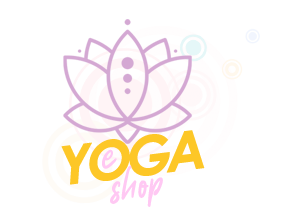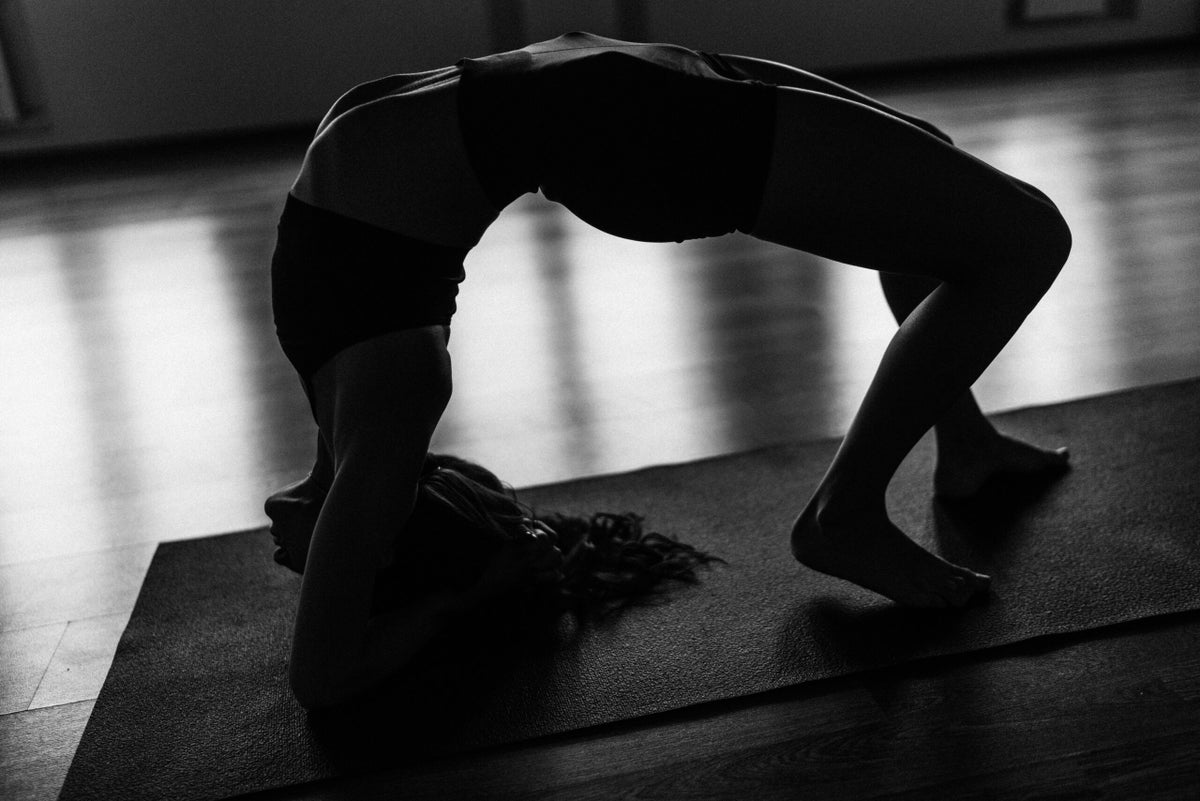
“], “filter”: { “nextExceptions”: “img, blockquote, div”, “nextContainsExceptions”: “img, blockquote, a.btn, a.o-button”} }”>
Heading out the door? Read this article on the new Outside+ app available now on iOS devices for members!
>”,”name”:”in-content-cta”,”type”:”link”}}”>Download the app.
Backbends in yoga tend to elicit strong emotional responses from most of us—and not just the expansive heart-opening ones some teachers talk about.
There’s a love and/or hate situationship that can take place. Maybe your enthusiasm about coming into the poses causes you to cast aside caution and overextend yourself. Or perhaps your exhaustion from attempting extreme versions like Wheel (Urdhva Dhanurasana) and Scorpion Pose (Vrschikasana) leaves you feeling frustrated.
But not all backbends are the same. Although all backbends have the potential to be beneficial, each has its own unique characteristics—including benefits as well as drawbacks.
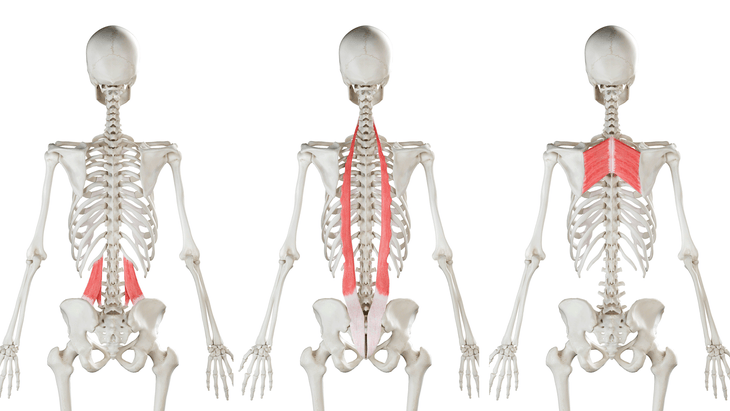
Anatomy of Yoga Backbends
All backbends shorten the length of key postural muscles on the back of your body to some extent. The muscles especially affected by backbends include the erector group running along either side of your spine, the quadratus lumborum found on either side of your low back, and the rhomboids and middle trapezius muscles in between your shoulder blades.
But how much your back body actually engages or not depends on the backbend.
Benefits of Yoga Backbends
The fact that yoga backbends take you out of your habitual forward posture creates an intrinsic benefit. These postures help balance the time you spend slouched on the couch or hunched forward over devices by taking you into the opposite shape. All backbends, in some measure, move your spine, stretch your chest, and lengthen your hip flexors.
But the most celebrated yoga backbends gain their graceful depth from external assistance, whether the pull of gravity or the grip of a hand, which can lend them aesthetic appeal but lessen their potential to be of benefit to your back body.
Types of Yoga Backbends
Some backbends focus on stretching the chest muscles while others focus more on strengthening the spine. Some are all about building strength while others depend on range of motion. Some are uplifting or energizing and others are, perhaps surprisingly, soothing.
There are essentially four types of backbends: active, gravity-assisted, those with binds, and passive. Each has distinct benefits as well as drawbacks that will play out differently in your unique body.
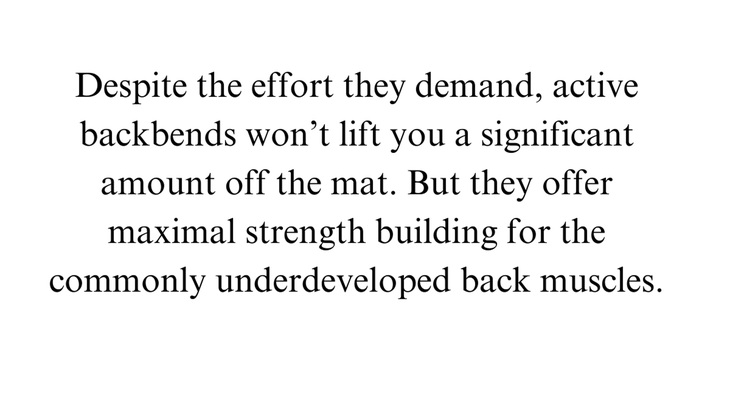
1. Active Yoga Backbends
Definition: These yoga backbends require you to actively contract your back body muscles to lift yourself against the downward pull of gravity. These humble backbending poses aren’t typically featured on social media. Despite the effort they demand, they won’t lift you a significant amount off the mat and are usually not something to make you stop your scroll.
Benefits: These poses offer maximal strength building for the commonly underdeveloped back muscles. And they do so in positions that don’t require extreme flexibility, which makes them accessible and useful for pretty much everyone and should figure consistently in your practice, especially cyclists and others who spend considerable time hunched forward.
Examples: These include Bridge (Setu Bandha Sarvangasana), Reverse or Upward Plank (Purvottanasana), Locust (Salabhasana), Cobra Pose (Bhujangasana), and, to some extent, Fish Pose (Matsyasana).

Bridge Pose
Pros: This reclined backbend is familiar and fairly accessible. Its face-up position focuses the workload principally on the glutes and hamstrings and provides an active way to engage and stretch tight hip flexors. A major positive of Bridge Pose is that the depth of backbend is infinitely variable—you can lift your hips as little or as much as you like.
Cons: The cons or negatives of Bridge Pose are few. There’s potential for hamstring cramps here, thanks to these commonly weak muscles being asked to work in a shortened position. If that happens, you can stop and stretch or press your feet down and away from you to encourage your quads to do more of the work. You might also take it as a cue to strengthen your hamstrings so they’re less likely to cramp next time.
Also, Bridge Pose demands that your quads work while lengthened, which generates tension on the quadriceps tendon that stretches over the front of your knee and makes knee pain a possibility for those who are sensitive to this kind of load. Changing your position slightly—hugging a block between your knees or walking your feet and knees wider apart and further away from your sit bones—will often resolve the issue.
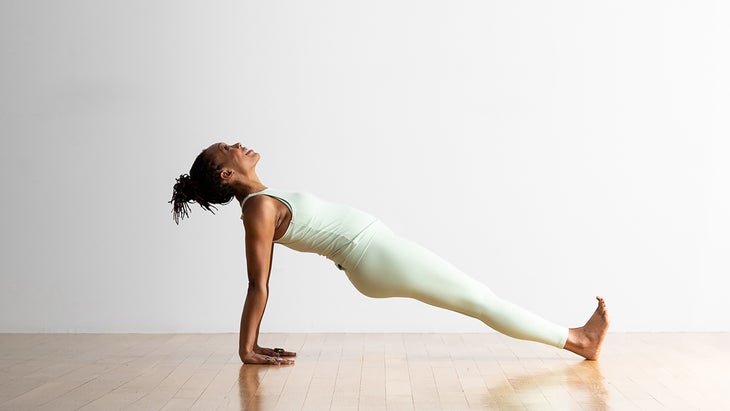
Reverse or Upward Plank
Pros: This pose works your entire back body, though you’re likely to feel Reverse or Upward Plank most vividly in your hamstrings, thanks to them being located midway between your hands and feet and therefore close to the center of the load.
Cons: The key challenge in Reverse Plank is that it requires above-average range of motion in your shoulders; if you aren’t able to move your arms far enough behind you to create the reverse tabletop position, you’re likely to compensate by rounding your shoulders. That causes you to lose the chance to build strength in your upper back (rhomboids and middle trapezius in particular). You’ll also miss out on a lovely stretch across the chest.
If you find your shoulders rounding forward in Reverse Plank, try not to walk your hands so far behind you. Before you lift your hips, squeeze your shoulder blades toward each other to broaden your chest. Keep that shoulder position and only lift your hips as high as you can without losing it.
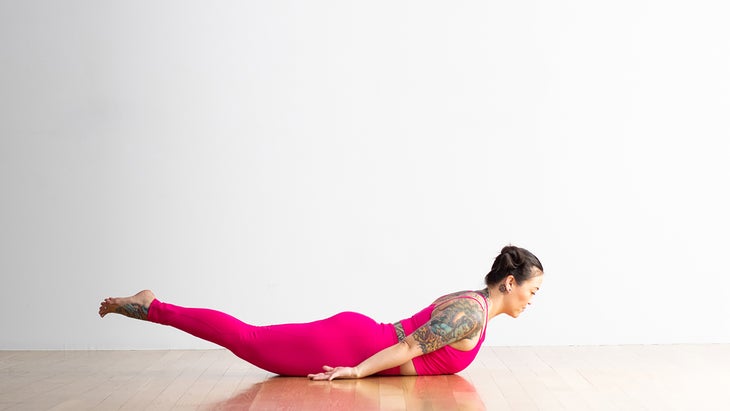
Locust Pose
Pros: This backbend is also relatively easy to work into your vinyasa flow and, compared to Cobra, it offers the added bonus of glute maximus and hamstring engagement (from lifting your legs) and upper body engagement in the rhomboids, middle traps, triceps and latissimus dorsi or lats (from lifting your arms and retracting your shoulder blades).
Cons: There’s really no downside to Locust. Your entire back body benefits from this pose and, like most active backbends, it’s very safe and accessible as you can only move as far into the pose as your strength allows. There is no way to take your joints into an unsafe position.
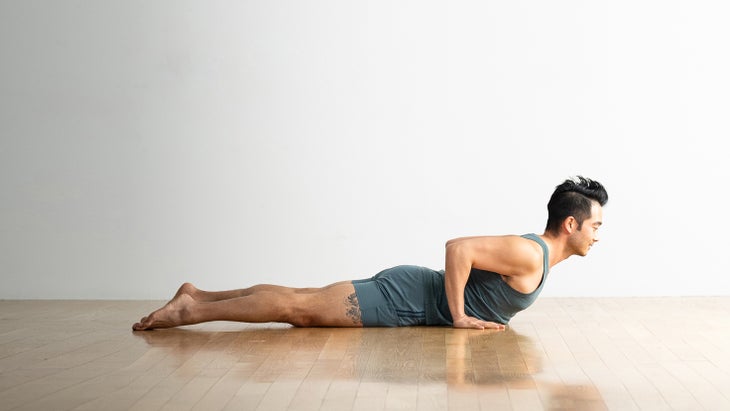
Cobra Pose
Pros: You can opt for this more accessible alternative anytime you might practice Upward-Facing Dog in a vinyasa or Sun Salutation. Doing Cobra provides opportunities to build strength in the relatively overlooked erector spinae and quadratus lumborum muscles of the back.
Cons: Pushing against the mat with your hands to help generate lift presents an inherent tradeoff between your back and upper body—the more you use your arms, the less you use your back muscles. There’s the potential that your arm strength could lift you higher than a comfortable range of motion, resulting in compression or discomfort in the vertebrae along the back of the spine.
The remedy? Don’t lift as high and aim to balance the work between the push of your hands and the pull of your back muscles.
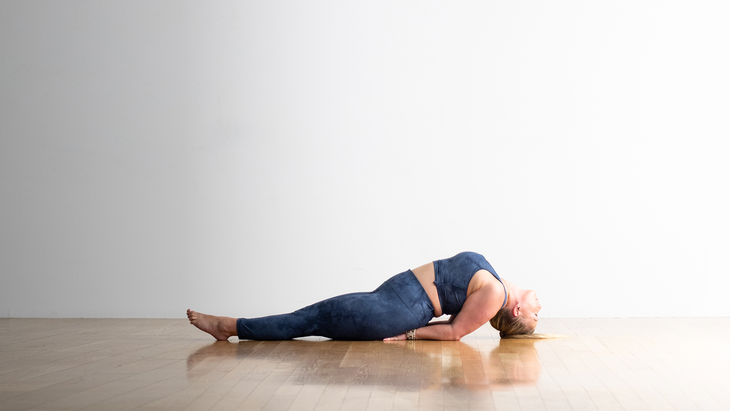
Fish Pose
Pros: This posture deserves an honorable mention in the active backbend family. Although Fish Pose (Matsyasana) is not completely active, it can be practiced in a way that offers back body strengthening with an accessible range of motion.
Fish taps into the commonly weak posterior shoulder and upper back muscles to create length across the chest and abdomen. It also stretches your front neck muscles if you choose to tip your head back slightly. To benefit from the strength-building potential of the pose, use your arms as actively as you can by squeezing your shoulder blades together and actively pushing the mat away from you instead of simply hanging out on your forearms.
Cons: The major drawback of this pose is not every neck enjoys this kind of extension. For some, lifting the chin while holding the weight of the head off the mat creates a pinch or compression in the back of the neck. If you experience that issue, tuck your chin slightly toward your chest or support your head on a block to make the pose more restful.
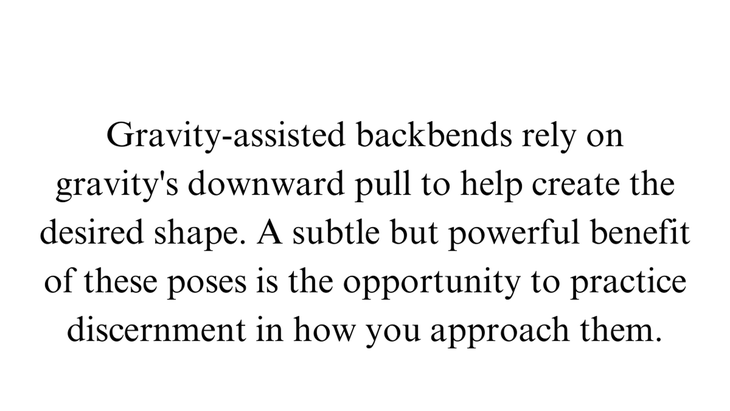
2. Gravity-Assisted Yoga Backbends
Definition: Whereas active backbends are almost entirely dependent on back body muscles working against gravity, other yoga backbends rely on gravity’s downward pull to help create the desired shape.
Think of Cow Pose (Bitilasana). Creating the hammock shape in your back is less about contracting your back muscles and more about relaxing your abdominal muscles and allowing gravity to draw your rib cage toward the mat. You can, of course, intensify the shape of the pose by contracting your back or lifting your chin, but gravity lends a significant helping hand.
Benefits: When you’re not relying on muscle strength alone, you’re able to move deeper into a backbend, which can be both a plus and a minus. On the plus side, you might be able to access more stretch in your opposing front body muscles. On the minus side, if you aren’t able to control or support this deeper range of motion, you might experience compression or irritation in the lumbar and cervical spine.
This can create a dilemma in that gravity-assisted full range of motion can create discomfort. Given how regularly these backbends feature in all-levels classes, a subtle but powerful benefit of these poses is the opportunity to practice discernment in how you approach them.
Examples: Other gravity-assisted backbends include Puppy (Uttana Shishosana), Upward-Facing Dog (Urdhva Mukha Svanasana), Camel Pose (Ustrasana), and, to some extent, Low Lunge (Anjaneyasana).
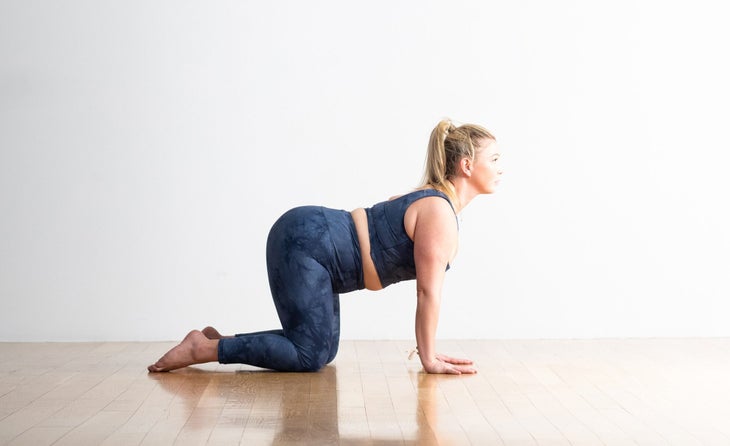
Cow Pose
Pros: Typically sequenced with Cat as a warm-up for the spine, Cow is one of the more accessible backbends. It can also be practiced while seated in a chair or on the mat (although that removes the assist from gravity).
Cons: The primary potential drawback is any discomfort experienced while bearing weight on your knees or palms. You can pad them with by folding your mat onto itself, sliding a folded blanket beneath you, or lowering onto your forearms instead of your hands. Or you can practice Cow Pose in a chair.

Puppy Pose
Pros: Essentially Cow Pose with your arms stretched forward on the mat, Puppy creates a significant chest and shoulder stretch in the pectoralis major, posterior deltoids, and lats.
Cons: This shape can generate a pinch in the top of the shoulder joint for those who don’t have the required range of motion. If you experience discomfort, walk your hands wider and angle them outward to create a Y-shape with your body or bend your elbows and rest your forearms far apart on the mat to see if that grants you the space you need.
Also, the overhead reach of your arms shifts the intensity of the backbend toward the place between your lumbar and thoracic spine. Because mobility tends to be more limited here, this can create discomfort in the lumbar spine. When you engage your upper abdominal muscles to draw your front ribs in and down, you might be able to create the needed support.
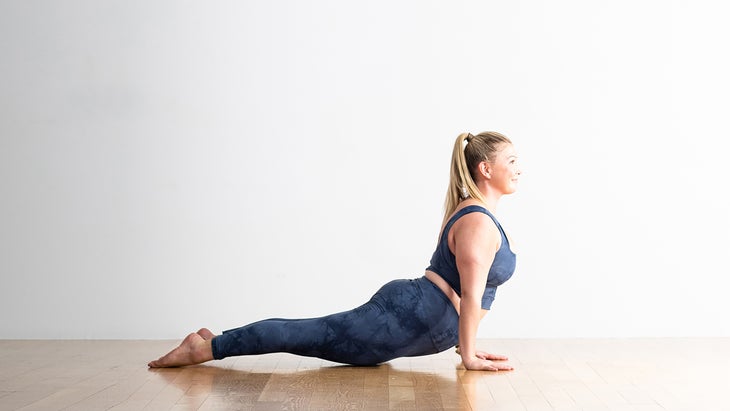
Upward-Facing Dog
Pros: One of the most frequently cued backbends in contemporary vinyasa classes, Upward-Facing Dog is commonly relied on as a transition between Chaturanga and Downward-Facing Dog (Adho Mukha Svanasana). It delivers a strong abdominal and hip flexor stretch and provides a place to practice maintaining upper body stability while opening your chest, which preps you for backbends such as Wheel and Scorpion.
Cons: Just because a pose is foundational doesn’t mean it’s accessible to everyone. The major challenge in Up Dog, in addition to possible wrist discomfort, is the potential for the backbend to be significantly deeper than is comfortable. Your hands and feet are locked in place, and if you relax your front body muscles, gravity effectively finds your full range of motion for you by drawing your low back and pelvis toward the mat, which can create low back compression.
To counter that, feel as if you’re dragging your hands and feet toward each other to try to wrinkle the middle of your mat. That engages your hip flexors and abdominals and might do the trick. If not, Cobra and Locust are excellent alternatives.
If you choose to lift your chin for a throat stretch, gravity also pulls the significant weight of the head backward, creating potential for compression in the cervical facet joints; if this feels problematic, tuck your chin slightly toward your chest.
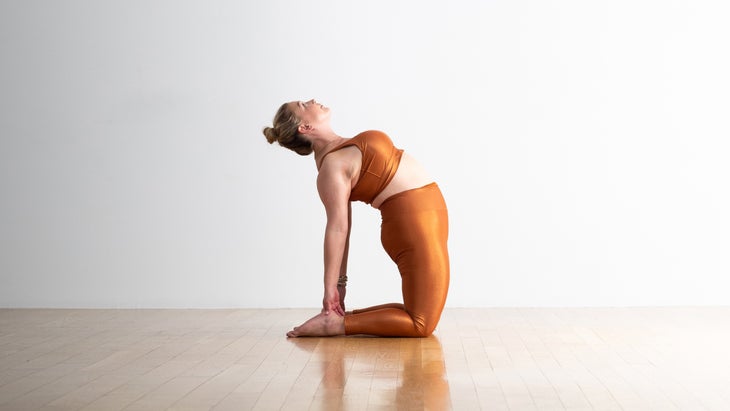
Camel Pose
Pros: This is another “love it or hate it” backbend that’s a regular feature in yoga classes. Camel Pose shares the same outward shape as Bridge Pose but its relationship to gravity is shifted in a way that delivers more vivid (some would say “intense”) sensation.
Best case scenario, you lengthen and strengthen your quadriceps, hip flexors, and anterior abdominal muscles without compressing your lower back. You would also squeeze your shoulder blades back and down to expand your chest.
Cons: Worst case scenario, the pull of gravity on your head and shoulders strains your neck and shifts the load to your low back, creating potential discomfort. As in Fish, Upward-Facing Dog, and Reverse Plank, you can choose whether or not to lift your chin depending on how it feels in the back of your neck.
Also, you might experience knee discomfort if you’re sensitive to the quadriceps tendon engaging in a lengthened position (which also happens in Bridge). Since your knees are in a fixed position on the mat, you can’t easily adjust your lower body as you can in Bridge. You could try leaning back less, placing your hands on either side of your sacrum, and keeping your hips over your knees. Or consider practicing Camel Pose while seated in a chair.
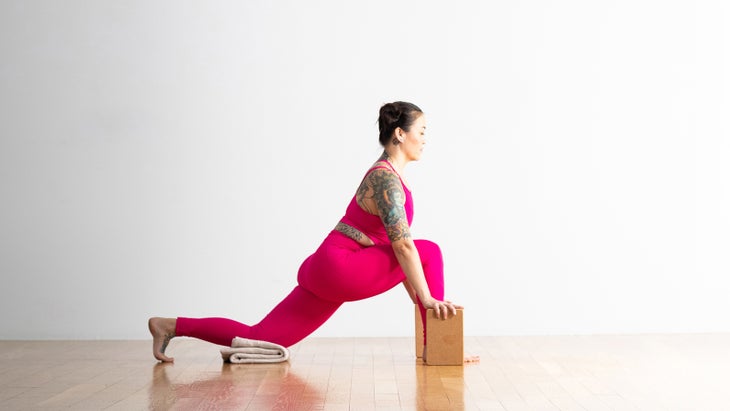
Low Lunge
Pros: A Low Lunge is essentially a one-sided backbend, making it worth mentioning. Similar to Up Dog in that the front foot and back knee are fixed on the mat, gravity determines much of the hip flexor stretch by pulling the weight of your pelvis toward the mat to assist with your range of motion. The additional front body length might create a useful stretch for hips, abdominals and chest without creating discomfort in the low back.
Cons: If you reach your arms up and back, gravity works on your upper body as it does in Camel. If that makes the sensation too intense, it could be helpful, or even necessary, to pull back and lift your arms shy of your full range of motion.

3. Yoga Backbends With Binds
Definition: Just as gravity can increase your range of motion in backbends, so can a bind between your upper and lower body. You create that either by gripping your ankles with your hands (or using a strap), such as in Bow (Dhanurasana) or Dancer (Natarajasana). You can also create a bind through fixed hand positions on the floor, such as in Upward-Facing Bow or Wheel.
Benefits: For better or for worse, we can achieve deeper range of motion with a bind than we can through muscle action alone. If your unique skeletal structure allows for range of motion in these poses, they can offer more intense stretches along the front body and, more subtly, a place to investigate finding expansiveness within a reasonable boundary or restriction.
If you don’t have the required range of motion, there’s even more potential for irritation in the back body structures as they move toward each other.
Examples: These poses include more dramatic yoga backbends such as Bow Pose (Dhanurasana), Dancer (Natarajasana), Wheel (Urdhva Dhanurasana), Pigeon (Eka Pada Rajakapotasana), Wild Thing (Camatkarasana), even Sphinx (Salamba Bhujangasana).
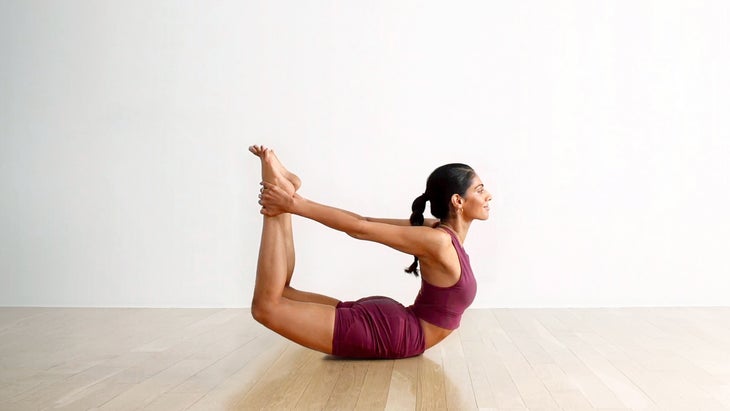
Bow Pose
Pros: This pose is the same general outward shape of Bridge and Camel. But the bind in Bow brings your head and feet together and intensifies the backbend. Although Bridge and Camel offer variations where hands meet heels, these are usually offered as options rather than standard alignment.
With an assist from the bind, there’s potential to lengthen and stretch the muscles of the commonly tight quads and hip flexors as well as chest and anterior shoulders (pecs and anterior deltoid especially).
Cons: On the minus side are the same back body compression and knee discomfort that can occur in Camel plus the higher-than-average shoulder range of motion that also takes place in Reverse Plank. Working just one side at a time can be helpful if you come close to the required range of motion for Bow, as can using a strap to link hands and feet or, of course, practicing Cobra or Locust instead.

Dancer Pose
Pros: This pose can be considered a one-sided version of Bow that includes the added benefit—and complication—of balancing on one foot. Dancer helps you build better standing stability by finding your poise in between the backward kick of the lifted foot and the forward leaning of the chest. You can opt for a using a chair or wall for support to help steady you.
You can also take an overhead bind in Dancer that pushes your spine and shoulder mobility even more intensely. If balance is your chief challenge in that variation, Pigeon with an overhead bind creates a similar shape but benefits from much greater stability from the increased support of the floor.
Cons: Essentially, the same cons of Bow Pose apply. As a deeper backbend, it offers the chance of a more intense front body stretch but also the potential for back body compression.
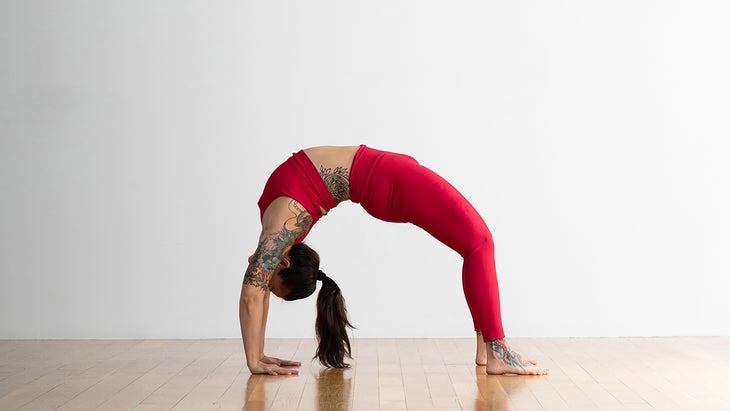
Wheel Pose
Pros: Although commonly referred to as Upward-Facing Bow Pose, Wheel is a substantially different backbend than Bow Pose. The changed orientation to gravity means that the entry into the pose is more like Bridge. While it does require more glute strength than Bow or Dancer to lift your hips off the mat and arm strength to lift your head and shoulders, it’s the position of your hands and feet that shapes your backbend here.
If you are able to find a version of Wheel you can work with, this pose takes us you as far away from slumped posture as is possible, mobilizing arms, shoulders, spine, hips and legs.
Cons: Although your hands and feet don’t need to meet, they are fixed in place on the mat. This requires above-normal mobility in the spine, shoulders, and hips, close to that of an overhead bind. This obviously creates potential for discomfort in the low back and shoulders. If you are close to the required range, variations in alignment—such as flaring your elbows wide, walking your feet and knees wider, even lifting onto your tiptoes—can help. You might also find Wild Thing, essentially a one-sided version of wheel, a little more accessible, though since only one hand is on the floor more balance is required.
Even so, you might be limited by the higher-than-normal wrist mobility required to plant your palms firmly enough on either side of your head to lift your upper body. You might try setting your hands on tilted blocks braced against the corner of floor and wall, or try a chair-supported version of Wheel where your hands catch the legs of the chair rather than having to find the floor.
King Pigeon (Kapotasana) shares the overhead arm position of Wheel, but uses your forearms and shins as your base. Creating an overhead bind between your hands and heels obviously deepens the backbend significantly, to an extent that requires well above normal mobility, and adds a potent upper body stretch, especially for your lats and triceps.
Sphinx Pose
Pros: This pose is also worth a mention. Technically Sphinx fits into the yoga backbends with binds category since your forearms and pelvis are fixed in place. But in terms of how it feels, its essentially a less-active Cobra Pose with more support from your upper body, hence their related names.
Cons: The primary benefit of Sphinx also leads to its leading drawback—the support of your elbows and forearms on the mat makes it easier to lift your chest and create a more intense backbend than is possible in purely active backbends. That increased lift might generate more of an abdominal stretch. But it could also create back body compression.
As with Fish Pose, if Sphinx is a comfortable option for you, maximize the strengthening benefits by actively pressing down through your elbows and forearms to work not just your spinal muscles but also key shoulder stabilizers including the serratus anterior along the side ribs.
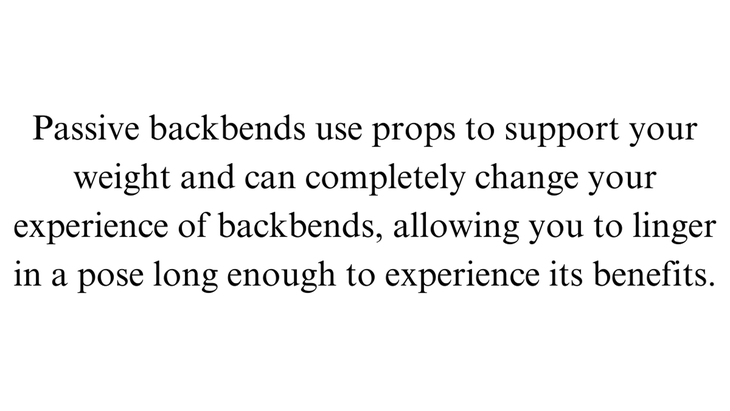
4. Passive or Restorative Backbends
Definition: Whereas pushing yourself to hold a backbend can be uncomfortable in active backbends, creating less-intense versions using props to support your weight.
Benefits: A passive approach to backbends can completely change the experience, allowing you to linger in a pose long enough for your front body tissues to unfurl and your breath to expand to fill its newfound space.
Examples: Supported Bridge, Supported Fish, and others. The details of where you feel the muscles lengthen and release will depend on where and how you arrange your props, so feel free to experiment to find the most restful version for you.
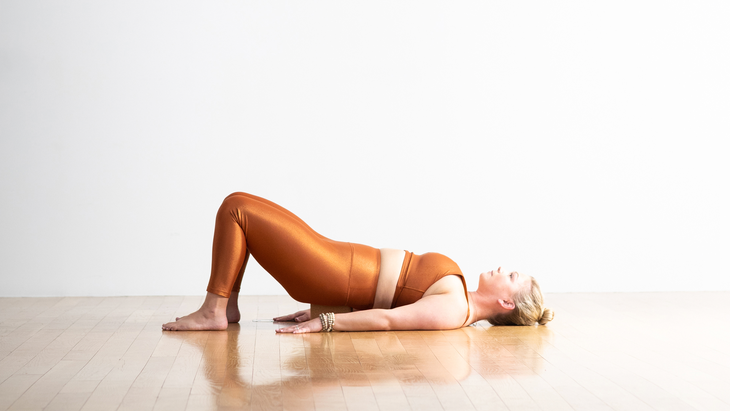
Supported Bridge
Pros: Placing props underneath the pelvis in Supported Bridge removes the need for back body strength, making the pose much more restful. You could also take the option of extending your legs to stretch the hip flexors along the front of the thighs, creating a perfect counter pose to prolonged sitting.
Cons: Even restorative backbends shorten the back body and create the potential for compression. If you feel pressure in your lumbar spine here, try making your prop smaller, like using a folded blanket instead of a bolster or block. Or slide the prop lower, toward your buttock, to subtly tilt the top of your sacrum and lower lumbar spine toward the mat into a more neutral position.

Supported Fish
Pros: Placing a bolster or rolled blankets lengthwise or widthwise underneath the mid back and shoulder blades in Supported Fish focuses the stretch on the chest and shoulders (namely, the pecs and anterior deltoids). It’s a chance to slowly and gently unwind slumped upper body posture to make space for deeper breaths.
Cons: You may experience a sense of compression in your back or neck. You can address this by rearranging your props to provide more support. Try extra padding underneath your head to ease the pressure or, if you’re using a bolster lengthwise along your spine, place a block at the far end beneath your head.
Once you start to understand the demands of the various yoga backbends, you might find yourself reframing these poses not as something you’re “good” or “bad” at but as tools to serve specific needs.
